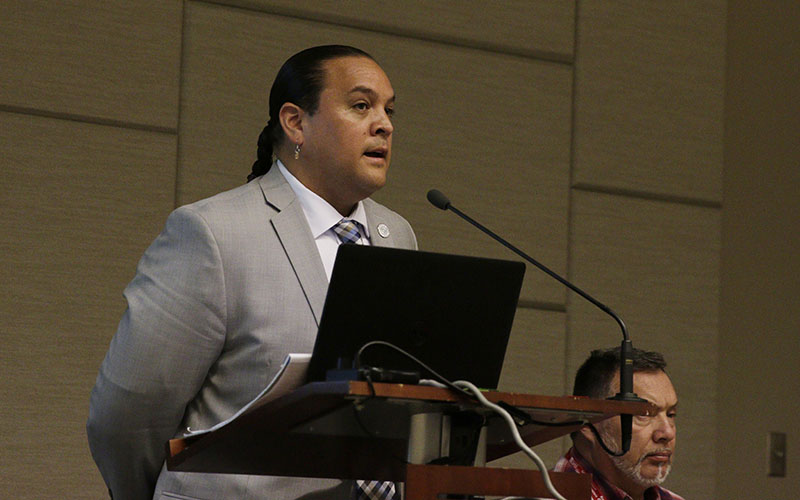
Kitcki Carroll moderated the panelists who presented at NCAI’s 73rd Annual Convention and Marketplace in Phoenix. (Photo by Courtney Columbus/Cronkite News)
PHOENIX – For Tara Mason, the impacts of addiction to opioids and other drugs on the White Earth Nation in Minnesota hit close to home.
The mother of nine has adopted four children. Last month, she became a foster parent to another child whose parents were addicts.
“We’re running out of homes, we’re running out of other places,” said Mason, the secretary and treasurer of the White Earth Nation.
Overdose deaths from opioid use are more prevalent among Native Americans than any other ethnic group.
At a recent National Congress of American Indians meeting in Phoenix, Mason was a panelist at a crowded session focused on opioid addiction. While the panelists shared strategies to combat opioid addiction, some of the 90 people who attended the event shared stories of personal experiences of addiction.
Mason said the hospital on the White Earth Nation reported five babies are born addicted to opiates each month. The statistics motivated her to help start an alternative treatment program for pregnant women in June 2015. The program uses the drug Suboxone to help women recover from opioid addiction.
As many as 60 mothers might attend the addiction program on any given day, she said.
The White Earth Nation, she said, “is moving forward.”
She said the community has also utilized the drug Narcan to save people who have overdosed on drugs. To date, they have 70 documented saves, she said.
Panelist Bob Bryant, a police chief on the Penobscot Nation in Maine, discussed a Penobscot judicial system that takes a holistic approach to helping addicts. Such ‘Healing to Wellness’ courts can help to put people who are addicted, have been arrested, or are facing charges on the path to recovery instead of in jail, said Bryant. A variety of people serve on the court, including medical professionals, members of law enforcement and counselors.
“We’re not going to arrest our way out of this problem,” Bryant said. But he added that the tribe still needs a law enforcement component in place to help connect addicts to the services they need.
“It’s not about punishment,” Bryant said. “It’s about getting folks off of these dreadful drugs.”
In 2014, almost 2 million Americans abused or were addicted to prescription painkillers, according to the National Survey on Drug Use and Health. But in 2014, 8.4 out of every 100,000 Native Americans died from overdosing on opioids. The rate was 7.9 for whites, 3.3 for blacks, and 2.2 for Latinos, according to an NCAI policy paper.
Opioids aren’t the only problem, however; panelists and audience members also spoke about experiences with heroin, meth or alcohol addictions. While deaths from opioid overdoses outpace deaths from heroin use in Indian Country, heroin still killed almost four out of every 100,000 Native Americans in 2014, the NCAI reported.
“This is an epidemic that impacts all of us,” said Kitcki Carroll, the executive director of the United South and Eastern Tribes.
“I’ve never seen anything like it in my lifetime,” said Bryant, of the Penobscot Nation. “How is this not our number one priority in all of our communities, and across the U.S.?”